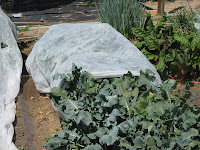 Is it just me or are many of you seeing more butterflies than average this summer? I also think I’m seeing fewer European paper wasps, a major predator of butterfly larvae. Perhaps that’s why.
Is it just me or are many of you seeing more butterflies than average this summer? I also think I’m seeing fewer European paper wasps, a major predator of butterfly larvae. Perhaps that’s why.The adults and larvae of butterflies require different food plants. The larvae of cabbage worm eat cabbage family plants (photo of damaged kale left, larva photo right). The white adult butterflies gather nectar from a variety of flowering plants (adult on thistle below left).

 Control of cabbage worm includes the use of the natural bacteria Bacillus thuringiensis Kurstaki strain. See the CSU Extension fact sheet on Bacillus thuringiensis for advantages and disadvantages of using this natural control. Another idea is to exclude the adult butterfly from laying eggs on plants with the use of a floating row cover (photo right).
Control of cabbage worm includes the use of the natural bacteria Bacillus thuringiensis Kurstaki strain. See the CSU Extension fact sheet on Bacillus thuringiensis for advantages and disadvantages of using this natural control. Another idea is to exclude the adult butterfly from laying eggs on plants with the use of a floating row cover (photo right). +July+27+2010.jpg)
A colorful butterfly plentiful throughout the Denver area this season is the Two-tailed swallowtail. Adults (photo left) feed on geranium, thistle and milkweed plus other flowers, larvae (photo right) consume green ash and chokecherry. Gardeners curious about the yellow butterflies flying by can now rest easy knowing the larvae are not eating their vegetables.

 To learn names, see photos, and find out the food plants for the adult and larval stages of common Colorado butterflies, see the CSU Extension fact sheet on butterflies in the garden.
To learn names, see photos, and find out the food plants for the adult and larval stages of common Colorado butterflies, see the CSU Extension fact sheet on butterflies in the garden.Photo credit:
Cabbage worm damage to kale, Carl Wilson
Cabbage worm larva, Whitney Cranshaw, CSU Extension
Adult cabbage worm butterfly, Davud Cappaert, Michigan State University
Row cover, Carl Wilson
Two-tailed swallowtail adult, CSU Extension
Two-tailed swallowtail larva, Whitney Cranshaw, CSU Extension








 Psyllids are insidious insects that cause a plant condition known as psyllid yellows, the result of a toxic saliva injected by the insect. Be on the lookout for these insects on your tomatoes and potatoes now.
Psyllids are insidious insects that cause a plant condition known as psyllid yellows, the result of a toxic saliva injected by the insect. Be on the lookout for these insects on your tomatoes and potatoes now.
